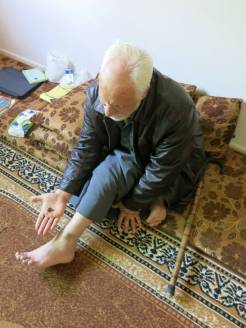By Sarah Gillam

Moustafa holds shrapnel which was removed from his ankle.
(c) S. Sommella / Handicap International
New research published today by HelpAge International and Handicap International provides new data showing how much older, disabled and injured Syrian refugees are struggling to meet their specific needs.
With Handicap International, we’re calling on all national and international humanitarian stakeholders providing assistance to Syrian refugees to change the way aid is delivered.
More precise targeting and registration of refugees, as well as better training of staff will ensure humanitarian assistance is accessible, appropriate and effective, says the report.
Vulnerable are most neglected
The Syrian crisis has now generated the largest refugee movement since the 1994 Rwandan genocide. The report shows that, hidden among the overall refugee population, disabled, injured and older refugees and those suffering from chronic diseases, are facing significant difficulties in accessing appropriate aid.
The most vulnerable are at far greater risk of falling through the gaps of humanitarian relief, with a bigger impact on their health, living conditions and social integration than for other refugees, as well as increased psychological distress.
Yet, studies of humanitarian assistance show how these same groups are often neglected in the assessment, the collection of data, design and delivery of humanitarian relief.
Report shows extent of trauma of older refugees
The report’s findings, based on primary data collected across 3,200 refugees, are stark:
- 30% of refugees in Jordan and Lebanon have specific needs: one in five is affected by physical, sensory or intellectual impairment, one in seven is affected by chronic disease, one in 20 suffers from injury, with nearly 80% of these injuries directly resulting from the conflict.
- 77% of older refugees are affected by impairment, injury or chronic disease.
- Refugees affected by impairment, injury or chronic disease are twice as likely as the general refugee population to report signs of psychological distress.
- 65% of older refugees present signs of psychological distress.
- 45% of refugees with specific needs have problems carrying out simple daily tasks.
Moustafa, for example is 62 and now lives in Jordan. A bomb hit his house in Homs in Syria two years ago, spraying his left ankle with shrapnel.
“One day, we were bombed for more than 12 hours,” he said. “That’s when we decided to flee.”
With his family, Moustafa has travelled from Syria to Lebanon and now Jordan in search of the medical help he needs but his ankle is still painful and hasn’t healed.
Aid needs to be tailored
“The lack of psychosocial or mental health care is a major challenge, significantly affecting the wellbeing of older people but also placing an additional burden on their families,” says Toby Porter, HelpAge CEO.
“Aid needs to be tailored specifically so that older, disabled and injured Syrian refugees are provided with appropriate treatment, so that this in turn may help to reduce the trauma of displacement.”
To ensure that people with specific needs are no longer the forgotten casualties of this conflict, we’re making eight joint recommendations, such as appropriate collection of information so that older, disabled and injured refugees can access essential services such as healthcare, income support and rehabilitation services.
